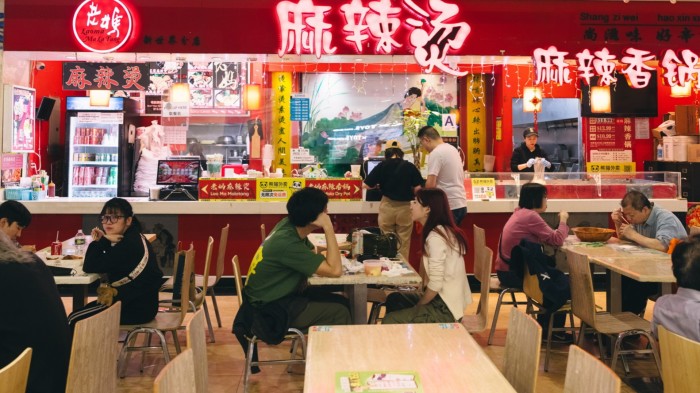This article is part of FT Globetrotter’s guide to New York
Ascending the subway steps at Roosevelt Avenue to the streets of my hometown, Flushing, Queens, feels like stepping through a portal into Asia. According to some estimates, Flushing is the largest and fastest-growing Chinatown outside Asia, with as many as 100,000 Chinese residents. It’s one of the rare places in America where having an Asian face doesn’t set you apart.
Flushing is also where you’ll find New York’s best east Asian food — from hand-pulled noodles to grilled Wagyu. In the supermarket, potato chip flavours include sushi, hotpot and roasted pork. Street vendors sell sticky rice wrapped in lotus leaves and dumplings stuffed with meat and chives.
I was born and raised in Flushing’s restaurant scene. My mom works as a waitress and my dad as a cook. I grew up on restaurant leftovers, and after school, my friends and I rode the Q17 bus to the countless bubble-tea shops on Main Street: first only Cantonese spots like Kung Fu Tea and Gong cha, and then Taiwanese entrants like Tiger Sugar and Xing Fu Tang.

To eat in Flushing is to witness transformations like this. In the 2010s, re-zoning allowed an inrush of luxury developers to make Flushing one of New York’s fastest-changing neighbourhoods. Many of the cheap, privately owned haunts I frequented in high school are gone, replaced by high-rises and upscale restaurants. But Flushing’s brand of gentrification is distinct: it is driven by immigrants who look a lot like the people they’re displacing. Small Cantonese and Korean restaurants have been edged out by mainland Chinese and Taiwanese joints, many of which are big chains in Asia.
Here’s a tour of the best of Flushing’s dining scene, according to me. As I take you from place to place, you’ll see how things have changed. To get there from Manhattan, ride the 7 train to the end of the line — or take the Long Island Railroad for a quieter, faster trip. Either way, pick a window seat and enjoy the above-ground views of Queens.
For dim sum the way it used to be
Asian Jewels Seafood Restaurant
133-30 39th Avenue, Flushing, NY 11354
-
Good for: Dim sum; gossiping on a Sunday afternoon with friends
-
Not so good for: Eating alone (apart from dim sum, the portions are large and tables are arranged for groups)
-
Price ($-$$$$): $$
-
Opening times: Monday-Friday, 10am-11pm; Saturday-Sunday, 9am-11pm
-
FYI: Its speciality is seafood. Walk in and you’ll see tanks filled with live red snapper and king crab

Asian Jewels has stood the test of time. Established in 2004, it’s one of Queens’ longest-running dim sum restaurants and arguably the most popular. Stepping inside feels like entering a banquet hall, with crystal chandeliers and crisp white tablecloths. The diners, however, are casual: families dressed in hoodies and jeans pass plates and bicker in Cantonese; kids play games on their parents’ phones.
On a Saturday afternoon, the place is crowded. Once seated, you’ll find a steady stream of wait staff pushing carts past your table loaded with bite-sized dishes. Here are the ones you shouldn’t miss: zhaliang, a fried dough wrapped in rice noodle and doused in soy sauce; flaky egg-custard tarts; and pan-fried eggplant stuffed with shrimp. Here’s how you order: point.

I’m a bit biased about Asian Jewels. My mom worked there for 15 years and, for a brief time, so did my dad. As a kid, I spent summers reading in the back, my mom’s coworkers sneaking me honey-glazed pork buns, the pages of my book sticky by the time her shift ended. Most of the workers from that time are still there, and when I walk in, they always marvel at how tall I’ve grown (I haven’t in years) and then ask the usual questions: how much I make (my journalist salary never impresses) and if I have a boyfriend (no).


Mei Tang, the restaurant’s receptionist and the owner’s sister, tells me they’ve lasted this long because they care about quality. Still, keeping the tradition alive is getting harder as more mainland Chinese immigrants move in, working-class Cantonese families climb the economic ladder and their children (like me) opt for careers outside of restaurants.
Between seating customers, she tells me that her brother, Kwai Hing Tang, now in his 60s, is searching for a successor: “There’s a narrower and narrower part of the world that serves this kind of food.”
For Flushing’s first craft cocktail bar
Leaf Bar and Lounge
Rooftop, Hyatt Place Hotel, 133-42 39th Avenue, Flushing, NY 11354
-
Good for: Fruity cocktails; rooftop views of Queens; drinks after the US Open
-
Not so good for: People who prefer dive bars. Some patrons complain about Manhattan prices in eastern Queens
-
Price: $$ (cocktails from $17)
-
Opening times: Sunday-Thursday, 5pm-1am; Friday-Saturday, 5pm-2am. Happy hour daily, 5pm-7pm
-
FYI: If it’s too crowded, try IYKYK, a 10-minute walk away and the newest speakeasy to open in Flushing
In a neighbourhood where it’s hard to find a drink without a side of hotpot or karaoke, Flushing’s craft cocktail scene was nonexistent until Leaf arrived on the rooftop of the Hyatt in 2015.
Leaf has Asian-inspired cocktails and Japanese beer on tap. My favourite drink is the Black Label Toki, a blend of Japanese whisky, scotch, amaro and curaçao. It’s a beautiful amber hue, and spicy and bitter in a way that jolts the brain. The drink is served with a single, perfectly spherical ice cube. There are also small bites if you get hungry, like three cup chicken, a Taiwanese classic of chicken cooked in a clay pot and soaked in soy sauce, rice wine and sesame oil.
Leaf is breezy and comfortable, with long sofas to lie back on and admire the Queens skyline. The bar is located in One Fulton Square, a multistorey complex that opened in 2015 and was developed by F & T Group, a Flushing-based real estate group behind other luxury developments in the area and a key driver of Flushing’s transformation.
Todd Leong, a California native who came to New York in the 1990s, started Leaf with F & T Group executive vice-president Helen Lee. He wanted to create a bar that Asian Americans could call their own, like the pub in the TV show Cheers. “The idea was to create a comfortable, relaxing oasis away from all the noise on Main Street,” he tells me.
The bar does have regulars, but it’s nicer than Cheers.
For a flamboyant Beijing-style scene
Juqi
133-36 37th Avenue, Flushing, NY 11354
-
Good for: Peking-duck enthusiasts, people who post food on their Instagram stories
-
Not so good for: A no-frills meal (the dishes are pricey and arrive in elaborate displays)
-
Price: $$$
-
Opening times: Sunday-Thursday, 11.30am-9pm; Friday-Saturday, 11.30am-9.30pm
-
FYI: Mark some time to walk around the mall Juqi is in. There’s a Japanese arcade, a Chinese toy store and, if you still have room, a food court with sweets like Taiwanese wheel cakes and matcha soft-serve

“The theatrics here are on point,” someone behind me says in the dining room at Juqi. I agree. Plates here are exquisitely presented: sliced duck topped with caviar arrives in a treasure box; dumplings, wrapped like bags of jewels, are served on dry ice.
Juqi is a popular Beijing chain. It chose Flushing as its first US location in 2022 in the new Tangram mall, a futuristic complex also co-developed by F & T Group.


For me, the change is bittersweet. Tangram, which sits across from Asian Jewels, replaced the Flushing Mall, a gritty two-storey hub of mom-and-pop shops and where I took Chinese dance and art lessons growing up. But it also brings upscale restaurants from China, where the experience is as important as the cuisine. In America, Chinese food is often stereotyped as cheap, fast and greasy, and China is considered an adversary — but these new restaurants showcase the diversity, elegance and cultural depth of its culinary scene, reminding patrons that there’s far more to the country than its relationship with the United States.

Juqi is a prime example. With its brick walls and street signs of Beijing, you feel like you’re wandering into the old courtyards and alleys of China’s capital city. The flagship dish here is oven-hung Peking duck served with sweet tianmian sauce and sliced vegetables. It tastes authentic, which is hard to find, even in Flushing, because the dish is so complex. At Juqi, they cook the duck in an eight-step process over 70 minutes, which involves soaking it in sweetened water and vegetable juice and torching the skin to get it crispy and burnt.
Another unmissable dish at Juqi is the Mr Rabbit Mashed Potato. It is borderline surreal, shaped like a rabbit, decorated with a full face and sitting in a gravy-like sauce. Juqi’s manager and chef Chuanming Zhu tells me the dish is inspired by a Chinese folktale about a rabbit god who healed a plague-ridden Beijing. “Food is important,” he says as I place a slice of duck on a rice paper roll, “but what we want is to spread the [Beijing] culture.”
For a taste of everything
New World Mall Food Court
136-20 Roosevelt Avenue, Flushing, NY 11354
-
Good for: A group that can’t decide what to eat; a cheap, casual lunch; exploring cuisines from across east Asia within steps of each other
-
Not so good for: Comfortable seating (it’s essentially lunch tables in a cafeteria)
-
Price: $
-
Opening times: Daily, 10am-10pm
-
FYI: Bring cash. Some vendors don’t take cards. And if you’re craving more Korean food, I have two suggestions: Chung Moo on Union Street is run by an old woman who didn’t want to talk to me for this piece. It’s very unassuming and has the best Korean food I’ve ever tasted (I’ve been going since high school). Alternatively, take a 15-minute ride on the Q13 bus to Northern Boulevard, the Korean centre of Flushing, for barbecue, fried chicken and soju slushies.

With more than 30 stalls, it’s hard to go wrong with the food court at the New World Mall, which opened in 2011 and was part of Flushing’s early mall boom. The food court distils the entire east Asian diaspora and everything that makes Flushing special into a windowless basement beneath a slightly worn mall. While newer malls offer sleeker eating spaces, none match New World’s combination of quality, price and range.
You can do a food tour throughout China just walking the floor, with offerings like Uyghur lagman (delicious hand-pulled noodles), Beijing-style jianbing (savoury crepes) and Chongqing spicy rice noodles, all for less than $15. You can also get Japanese tonkotsu ramen and Korean classics like kimchi jjigae.

My favourite stall is Laoma Ma La Tang, where I order the Szechuan dry pot (a stir-fried version of hotpot). First, choose your meats or seafood, from sliced beef to fish balls, plus vegetables like seaweed, enoki mushrooms and napa cabbage, then decide how fiery you want the mouth-numbing spice. (Be careful with this step.)
To cool down, I head to Tiger Sugar for its Taiwanese bubble tea and latte mix, topped with cream mousse and chewy tapioca pearls braised in a brown-sugar syrup.
It’s hard to find a table at New World Mall on weekends. If it’s too crowded, head to the New York Food Court, which is lesser known but equally good and a five-minute walk down Roosevelt Avenue. There you can get everything from durian pizza to fried pork chops.
To experience the hotpot revolution
Chongqing Lao Zao
37-04 Prince Street, Flushing, NY 11354
-
Good for: Big groups
-
Not so good for: People who don’t like spice
-
Opening times: Monday-Thursday, noon-1.30am; Friday, 11.30am-1.30am; Saturday–Sunday, 11am-1.30am
-
Price: $$$ (a bit more expensive than average for hotpot)
-
FYI: They don’t take reservations. Put your name down an hour or two early and check out the neighbourhood
My dad often complains that every restaurant in Flushing is now a hotpot place. He’s not wrong. As popular Chinese chains like Haidilao and Shoo Loong Kan jump on Flushing’s real estate boom, it feels like a new one opens every week. Yet, despite the endless options, there’s always a line at Chongqing Lao Zao.
The food is good here, but the experience is unparalleled. From its exterior down to its tea cups, the restaurant harks back to a premodern time in China. The exterior looks like an old village house decorated with red lanterns and a large wooden door. Inside is a waterwheel, and cups featuring Mao Zedong and Communist slogans such as “Labour moves us forward”. My friend says the place reminds him of a Chinese Cracker Barrel. I think it’s a little nicer than that.
Chongqing is a city in south-west China known for its mouth-numbing spicy cuisine, and Lao Zao means “old stove”. Here’s what you should know: first, pick your broth and the spice level. Then select your meats, seafood and vegetables. A must-try is the tai chi beef, which comes covered in green and red chillies arranged in a yin-yang sign.
If you’re feeling adventurous, try the assortment of organs. Last time, I had the pig brain. It comes raw, sitting on a single lettuce leaf, and is larger than I expected — sort of what I imagine a human brain would look like. Cook it for 15 minutes (we did it for 20 for good measure).
The texture is creamy, like pâté. It’s probably something I won’t get again. Next time, I might try the beef aorta or the bull pizzle.
Do you have a favourite eatery in Flushing? Tell us in the comments below. And follow FT Globetrotter on Instagram at @FTGlobetrotter
Cities with the FT

FT Globetrotter, our insider guides to some of the world’s greatest cities, offers expert advice on eating and drinking, exercise, art and culture — and much more
Find us in New York, Paris, Rome, London, Tokyo, Lagos, Frankfurt, Singapore, Hong Kong, Miami, Toronto, Madrid, Melbourne, Copenhagen, Zürich, Milan, Vancouver, Edinburgh and Venice









